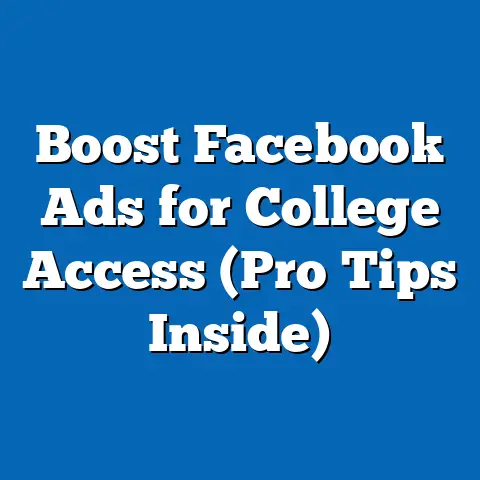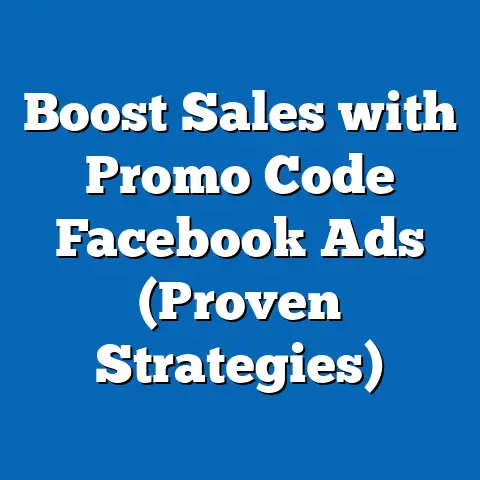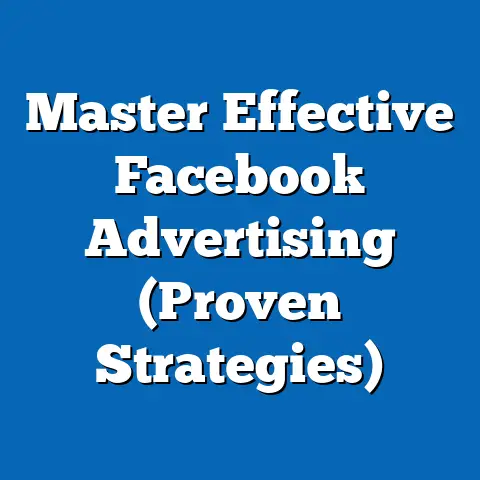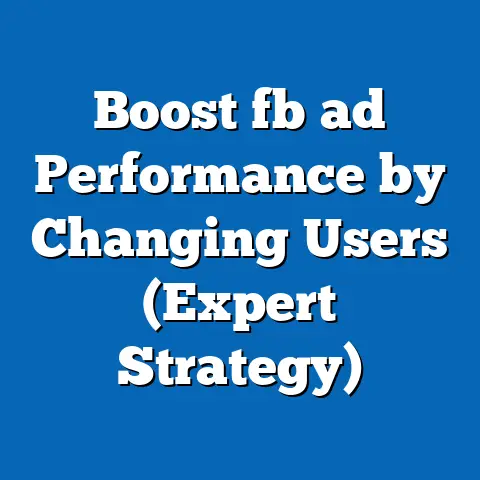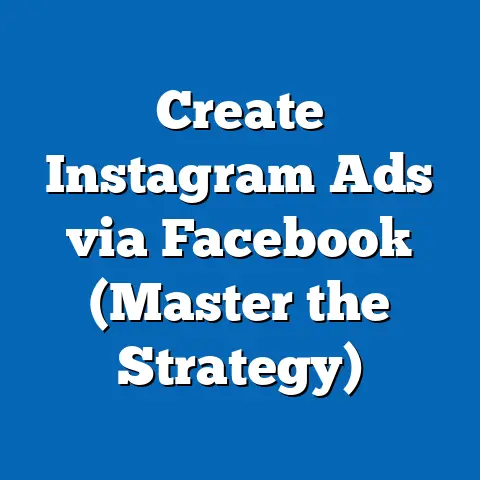Maximize Facebook Ad Campaigns (Expert Strategy Guide)
I’ve seen firsthand how Facebook ads can be a game-changer for businesses of all sizes. But let’s be real – the platform is constantly evolving, and what worked yesterday might not work today. The competition is fierce, and the costs? They can climb faster than a viral TikTok trend. That’s why I’m diving deep into the strategies that can help you not just survive, but thrive in the world of Facebook advertising. I want to share my expertise, built from years of experience and countless campaigns, to help you achieve a return on investment that makes your marketing budget sing.
Understanding Facebook Ads: The Foundation
Before we get into the nitty-gritty, let’s lay the groundwork. Facebook Ads, at its core, is a powerful system structured around three main components:
- Campaigns: This is the overarching container for your advertising efforts. It defines your primary objective, like generating leads or increasing brand awareness.
- Ad Sets: Within a campaign, ad sets allow you to segment your audience, set budgets, and schedule your ads. Think of them as mini-campaigns focused on specific groups of people.
- Ads: These are the individual creative pieces your audience sees – the images, videos, and text that convey your message.
And the types of ads? Oh, there’s a whole buffet:
- Image Ads: Simple and effective, these use a single eye-catching image to grab attention.
- Video Ads: Perfect for storytelling and demonstrating your product in action.
- Carousel Ads: Showcase multiple products or features in a single ad unit.
- Slideshow Ads: Create a video-like experience using a series of images.
- Collection Ads: Ideal for e-commerce, allowing users to browse products directly from the ad.
Each ad type has its strengths. I’ve found that video ads are great for building brand awareness, while carousel ads excel at driving product sales.
But here’s the kicker: none of this matters if you’re not targeting the right people. Facebook’s targeting options are incredibly granular, allowing you to reach users based on:
- Demographics: Age, gender, location, education, job title, etc.
- Interests: Hobbies, passions, and things they’ve expressed interest in on Facebook.
- Behaviors: Past purchase behavior, device usage, travel habits, and more.
The more precise your targeting, the more likely you are to reach people who are genuinely interested in what you have to offer.
Takeaway: Facebook Ads are a multi-layered system, and understanding the different components and ad types is crucial for success. Precise targeting is the key to reaching the right audience.
Setting Clear Objectives: Knowing Your “Why”
I can’t stress this enough: before you spend a single dollar on Facebook Ads, you need to know exactly what you want to achieve. Are you trying to:
- Increase Brand Awareness? Get your name out there and make sure people recognize your brand.
- Drive Traffic to Your Website? Send potential customers to your online store or landing page.
- Generate Leads? Collect contact information from people interested in your product or service.
- Increase Engagement? Get people to like, comment, and share your content.
- Drive Sales? Directly sell products or services through your ads.
Facebook Ads Manager offers different campaign objectives aligned with these goals:
- Awareness: Reach – Show your ad to the maximum number of people.
- Consideration: Traffic, Engagement, App Installs, Video Views, Lead Generation, Messages.
- Conversion: Conversions, Catalog Sales, Store Traffic.
I’ve seen campaigns fail simply because the advertiser didn’t clearly define their objective. It’s like setting sail without a destination – you’ll just drift aimlessly.
Aligning your ad objectives with your overall business goals is essential. For example, if your goal is to increase online sales by 20% this quarter, your Facebook ad campaigns should focus on conversion objectives like “Conversions” or “Catalog Sales.”
Takeaway: Setting clear, measurable objectives is the foundation of a successful Facebook ad campaign. Make sure your ad objectives align with your overall business goals.
Audience Targeting Strategies: Finding Your Tribe
This is where the magic happens. Facebook’s targeting options are incredibly powerful, allowing you to laser-focus on the people most likely to become your customers. Here’s a breakdown of some key strategies:
- Custom Audiences: This is where you upload your existing customer data (email lists, phone numbers, website visitors) to create highly targeted audiences. I’ve used this to retarget website visitors who abandoned their shopping carts, and the results were phenomenal.
- Lookalike Audiences: This is where Facebook finds new users who are similar to your existing customers. It’s like cloning your best customers! I typically use a seed audience of my top 10% of customers to create a lookalike audience.
- Detailed Targeting: This is where you can target users based on demographics, interests, and behaviors. I’ve found that combining multiple targeting options can create incredibly specific audiences.
Let’s say you’re selling organic dog food. You could target:
- Demographics: Pet owners, age 25-55, living in urban areas.
- Interests: Organic food, dog lovers, pet health.
- Behaviors: People who have purchased pet supplies online, people who have interacted with dog-related content on Facebook.
A/B testing different audience segments is crucial. Try running the same ad creative to different audiences and see which one performs best. You might be surprised at what you discover.
Takeaway: Facebook’s audience targeting options are incredibly powerful. Use Custom Audiences, Lookalike Audiences, and Detailed Targeting to reach the right people. A/B test different audience segments to optimize performance.
Crafting Compelling Ad Creatives: Making ‘Em Stop and Stare
Your ad creative is what grabs people’s attention and convinces them to take action. It’s the face of your campaign, and it needs to be compelling. Here are the key elements:
- Visuals: High-quality images or videos that are relevant to your target audience and brand. I always recommend using professional-quality visuals, even if it means investing in a photographer or videographer.
- Copy: Persuasive and concise text that highlights the benefits of your product or service. Focus on what’s in it for the customer.
- Call-to-Action: A clear and compelling prompt that tells people what you want them to do (e.g., “Shop Now,” “Learn More,” “Sign Up”). Make it easy for them to take action.
Here are some tips for creating engaging visuals:
- Use bright colors and eye-catching designs.
- Showcase your product in action.
- Use faces to connect with your audience on an emotional level.
- Keep it simple and uncluttered.
For persuasive ad copy, try these techniques:
- Highlight the benefits, not just the features.
- Use strong verbs and action-oriented language.
- Create a sense of urgency or scarcity.
- Address your target audience’s pain points.
And don’t forget to A/B test different creatives! Try different images, headlines, and call-to-actions to see what resonates best with your audience.
Takeaway: Compelling ad creatives are essential for grabbing attention and driving action. Use high-quality visuals, persuasive copy, and clear call-to-actions. A/B test different creatives to optimize performance.
Budgeting and Bidding Strategies: Spending Wisely
Setting the right budget and choosing the right bidding strategy can make or break your campaign. Here’s what you need to know:
- Daily vs. Lifetime Budgets: Daily budgets allow you to spend a fixed amount each day, while lifetime budgets allow you to spend a fixed amount over the entire duration of your campaign. I typically use daily budgets for ongoing campaigns and lifetime budgets for short-term promotions.
- Automatic vs. Manual Bidding: Automatic bidding allows Facebook to automatically adjust your bids to get the most results for your budget. Manual bidding allows you to set your own bids, giving you more control over costs. I recommend starting with automatic bidding and then switching to manual bidding once you have enough data to make informed decisions.
Here are some tips for budgeting and bidding:
- Start small and scale up: Don’t blow your entire budget on your first campaign. Start with a small budget and gradually increase it as you see results.
- Monitor your costs closely: Keep an eye on your cost per click (CPC), cost per impression (CPM), and cost per conversion (CPC). If your costs are too high, adjust your targeting, creatives, or bidding strategy.
- Use bid caps: If you’re using manual bidding, set bid caps to prevent your bids from spiraling out of control.
Takeaway: Choose the right budget option and bidding strategy for your campaign goals. Monitor your costs closely and adjust your bids as needed.
Analyzing and Optimizing Campaign Performance: The Data Tells All
The data from your Facebook Ads Manager is the compass that guides you to success. You need to understand what the key performance indicators (KPIs) mean and how to use them to optimize your campaigns.
Here are some of the most important KPIs to track:
- Click-Through Rate (CTR): The percentage of people who click on your ad after seeing it. A high CTR indicates that your ad is relevant and engaging.
- Cost Per Click (CPC): The amount you pay each time someone clicks on your ad. A low CPC indicates that you’re targeting the right audience and using effective ad creatives.
- Cost Per Mille (CPM): The amount you pay for 1,000 impressions of your ad. CPM is useful for measuring brand awareness campaigns.
- Conversion Rate: The percentage of people who take a desired action (e.g., make a purchase, sign up for a newsletter) after clicking on your ad. A high conversion rate indicates that your landing page is effective and your offer is compelling.
Here’s how to use this data to optimize your campaigns:
- Adjust Targeting: If your CTR or CPC is too high, try narrowing your targeting or testing different audience segments.
- Refine Creatives: If your CTR is low, try testing different images, headlines, or call-to-actions.
- Optimize Landing Pages: If your conversion rate is low, make sure your landing page is relevant to your ad and easy to navigate.
Retargeting campaigns are another powerful optimization technique. Retargeting allows you to re-engage potential customers who have already interacted with your brand (e.g., visited your website, viewed your products).
Takeaway: Track your KPIs closely and use the data to optimize your campaigns. Retargeting campaigns are a powerful way to re-engage potential customers.
Conclusion: Constant Evolution is Key
Mastering Facebook Ads is an ongoing process. The platform is constantly evolving, and what works today might not work tomorrow. That’s why it’s crucial to stay up-to-date on the latest trends and best practices.
By implementing the strategies I’ve outlined in this guide, you’ll be well on your way to maximizing the effectiveness of your Facebook ad campaigns. Remember to set clear objectives, target the right audience, create compelling ad creatives, manage your budget wisely, and continuously analyze and optimize your performance.
Now, it’s your turn. Start applying these strategies to your Facebook ad campaigns and see the tangible improvements in your results. Don’t be afraid to experiment, test new ideas, and learn from your mistakes. The more you practice, the better you’ll become at harnessing the power of Facebook Ads to achieve your business goals.

